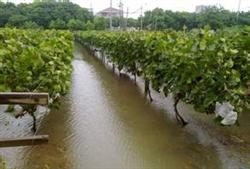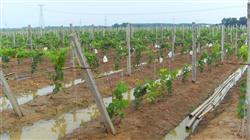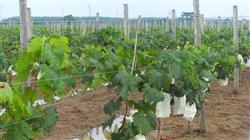Grape planting techniques: why should summer grapes be waterlogged?

Why should summer grapes be waterlogged? Please introduce the reason and how to prevent yellow leaves, fallen leaves, falling fruit and fruit cracking in the early stage after flooding. The root system soaked in water for a long time caused leaf rolling, winter bud germination, root asphyxiation and rotten root, wilting and death of the whole plant. 1. Preventive measures 1. In order to prevent the orchard from being damaged by waterlogging, the orchard should be selected, soil and water conservation and soil improvement should be done well, and ditches should be opened to change soil for planting if necessary. In rainy areas, terraces or deep ditches and high borders can be used to cultivate grapes to facilitate drainage. two。 Drainage facilities should be repaired in low-lying areas prone to stagnant water, and ridges can be planted in plain areas. 3. Do not blindly use plant growth regulator products. In rainy season, the swelling and pressure of mature grape fruit increases sharply, if the external use of plant growth regulators may aggravate fruit cracking, resulting in a significant decline in grape quality. 4. Conditional vineyards can adopt the mode of rain shelter cultivation to prevent waterlogging and reduce the occurrence of diseases and insect pests. Second, remedial measures 1. Dredge channels and eliminate stagnant water as soon as possible. Drain the stagnant water from the vineyard in time after rain, straighten the plant, remove the excess water in the centralized distribution layer of the root system in time, and solve the breathing problem of the root system. A drainage ditch with a depth of 60 cm and a width of 40 cm can be dug every 2-3 rows of trees in the garden. two。 Ploughing in time to improve soil moisture. After flooding, the vineyard soil is easy to harden, causing hypoxia in the roots. Carry on the deep turning of the tree plate or the whole garden to facilitate the distribution of soil water, strengthen ventilation and promote the growth of new roots. 3. Strengthen tree protection and actively prevent and control diseases and insect pests. 0.1%-0.2% potassium dihydrogen phosphate or 0.3% urea solution can be used for foliar topdressing. After the tree is restored, the mature human and animal feces, urine and cake fertilizer will be applied to promote the development of new roots. Try to use Bordeaux liquid and other internal absorbent protective agents before rain, leave the ground slightly dry after rain, and use Bordeaux liquid and fungicides alternately. 4. Timely pruning and timely harvest. Cut off broken vines in time to remove fallen leaves, diseased fruit and rotten fruit. For trees with serious root injury, branch thinning, leaf cutting and fruit removal should be done in time to reduce transpiration and prevent plant death. Vineyards that have been flooded for a long time should be harvested ahead of time. Orchards that are less affected and unaffected should be graded and harvested in batches, and late-maturing varieties should not be picked early as far as possible. 5. Do a good job of cold prevention in order to survive the winter. For the areas that need to bury the soil to prevent cold, the thickness of the buried soil is thicker than in previous years, and the soil is taken away from the root system to prevent the occurrence of grape frost damage. Click to get more grape planting techniques click to get more fruit planting techniques
- Prev

Grape planting techniques: how to manage summer grapes?
How to manage summer grapes? Please give guidance on how summer grapes can be managed with reference to the following methods: 1. Branch management. 1. The new shoots of grape seedlings raised by wiping branches and cuttings grow to 40-50 cm in mid-July. Some seedlings have several new shoots or several secondary shoots of a new shoot, which must be wiped and left in time.
- Next

Grape planting techniques: what are the diseases of summer grapes?
What are the diseases of summer grapes? Please introduce and introduce the control methods of grape planting in summer, especially the prevention and control of black pox, white rot, anthracnose and downy mildew. Give priority to prevention and spray in time. For drugs with a residual period of 17 mi for 21 days, they are generally sprayed every 15 days.
Related
- Moge, come on! The staff of the peasant association in the producing area of cantaloupe were frightened when the crowd gathered.
- Causes and Solutions of low Fruit setting rate of Apple
- Symptoms and control measures of passion fruit virus disease
- Fruit growing lesson: how do apple orchards keep high yields?
- Can you build orchards in the mountains? What are the pros and cons?
- How to manage the coloring period of Crisson grape?
- This paper introduces the processing technology of two kinds of fig products.
- How much is a month for retired teachers in rural areas by 2020?
- How can strawberry planting increase sugar content? We should pay attention to management in many aspects.
- What are the cultivation techniques on how to improve the yield of golden fruit?

